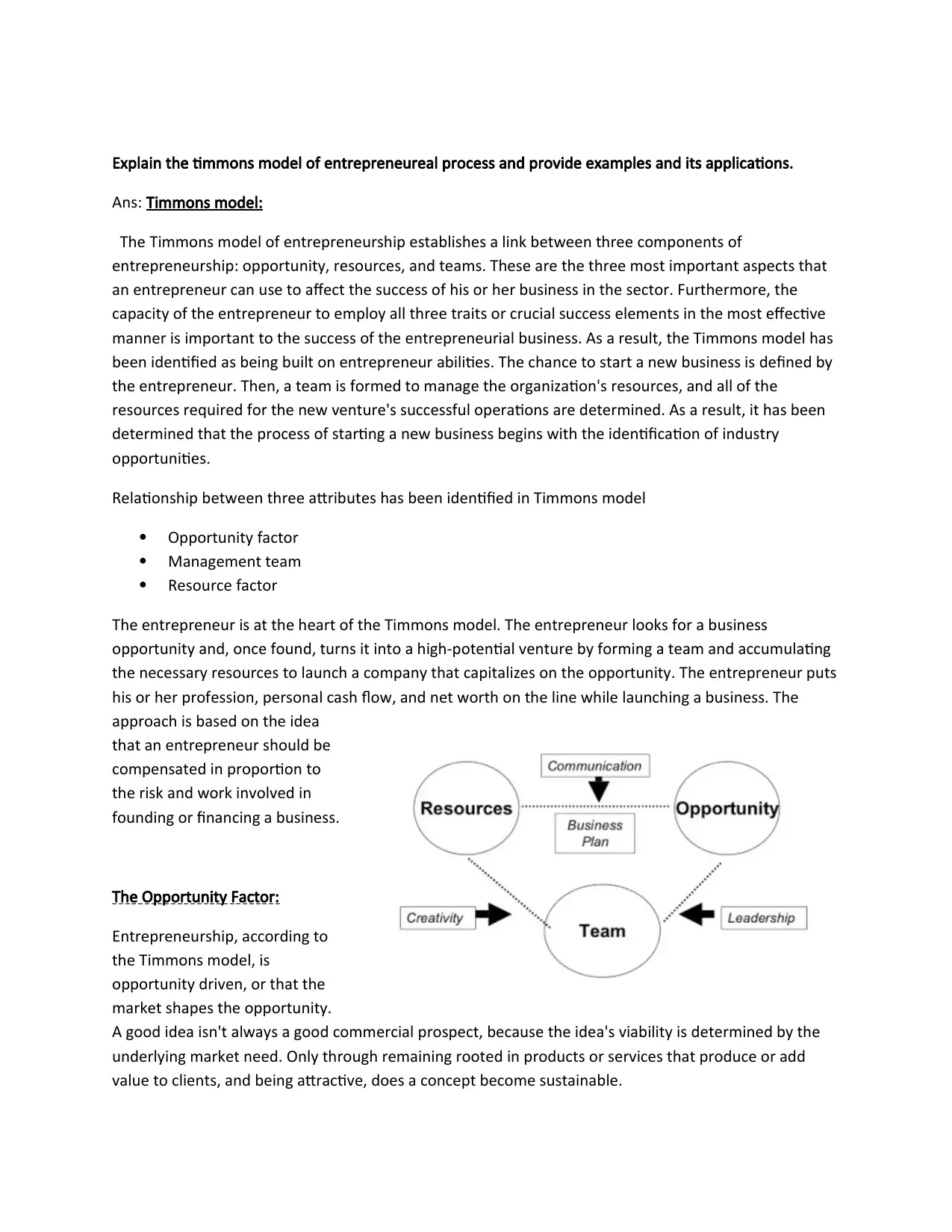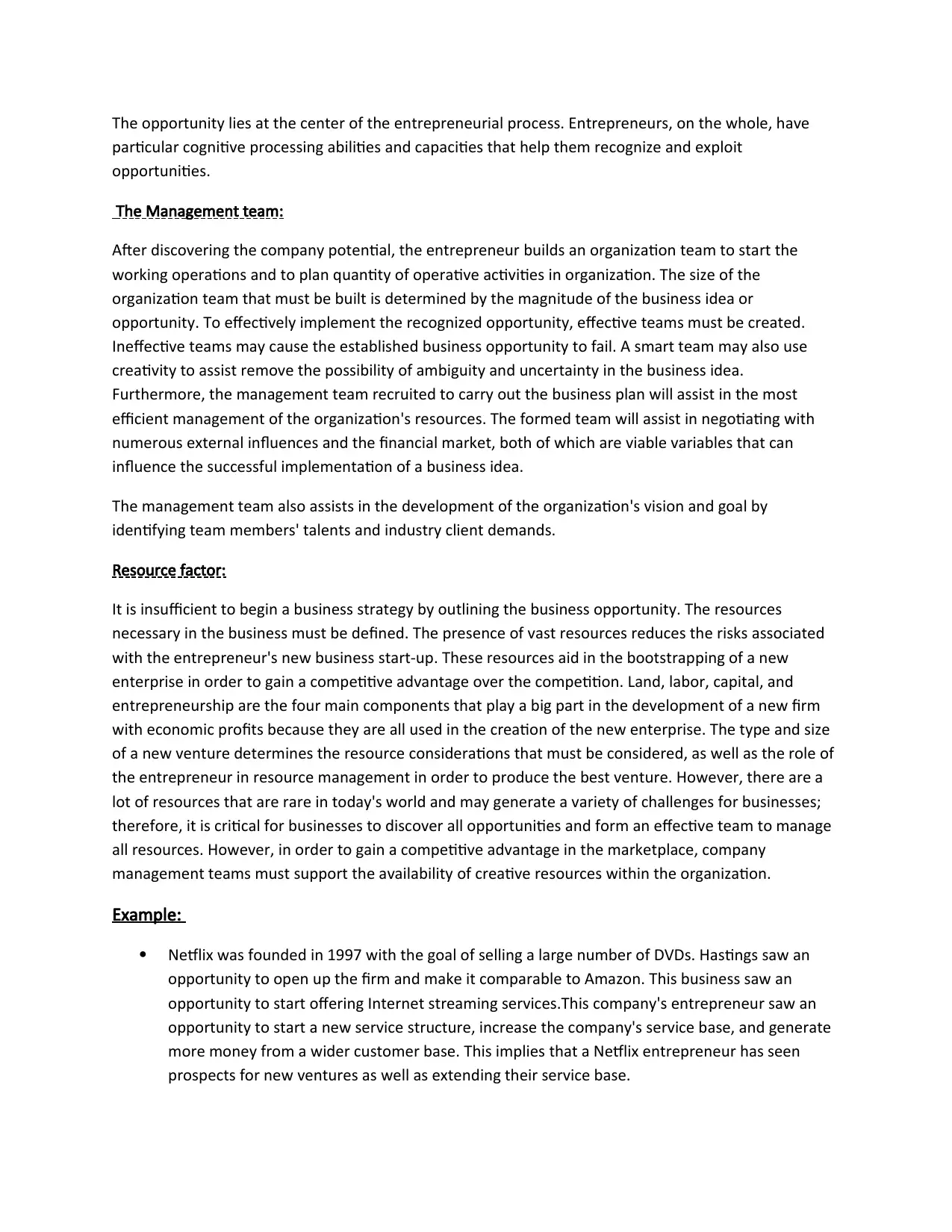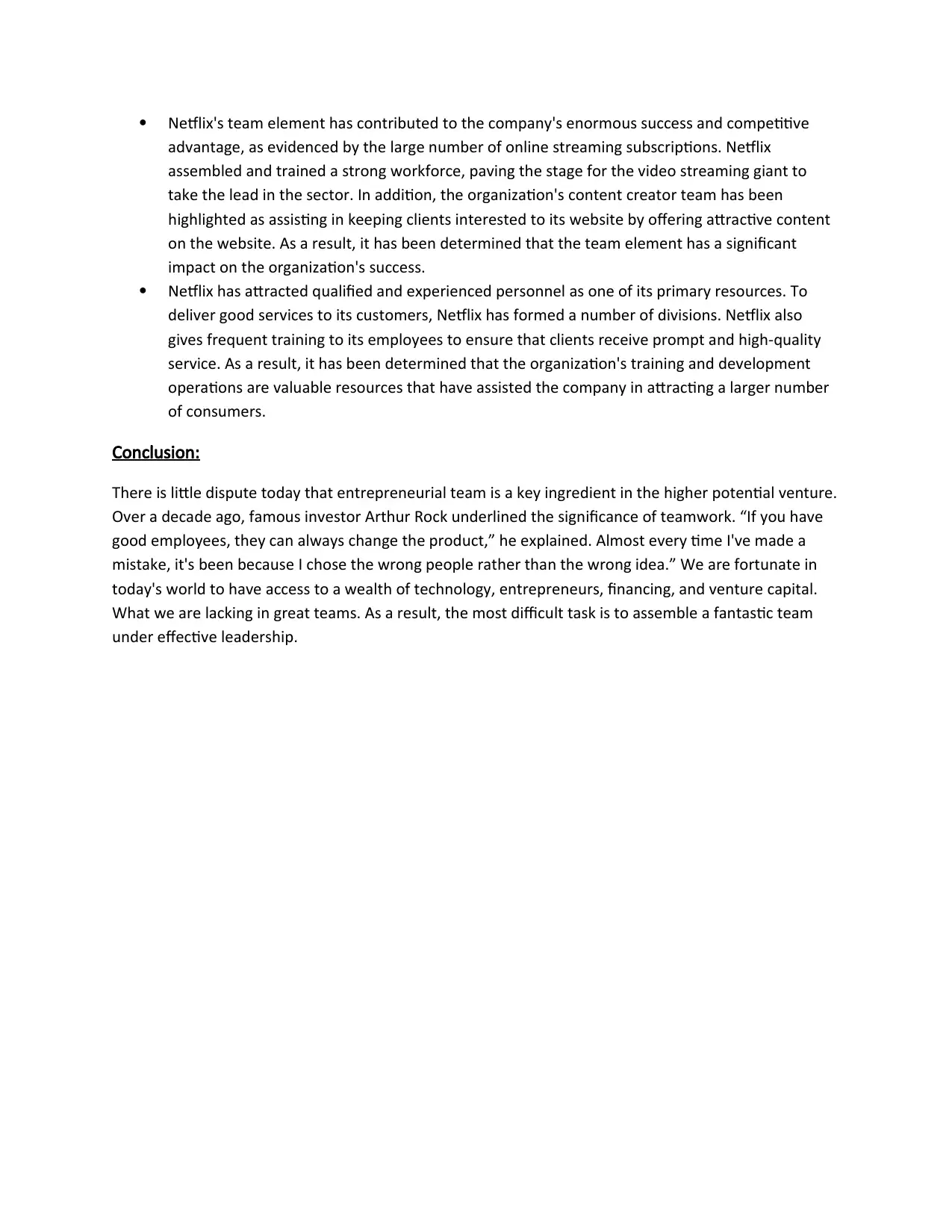Business Development: An Analysis of the Timmons Entrepreneurial Model
VerifiedAdded on 2021/09/27
|3
|1205
|276
Homework Assignment
AI Summary
This assignment provides a comprehensive explanation of the Timmons model of entrepreneurship, a framework that highlights the interconnectedness of opportunity, resources, and the management team. It emphasizes the crucial role of the entrepreneur in identifying market opportunities, assembling a capable team, and securing necessary resources for a new venture. The model underscores the importance of aligning these three elements for business success, highlighting the risk-reward balance and the significance of a strong management team in navigating challenges and maximizing opportunities. Real-world examples, such as Netflix, illustrate the practical application of the Timmons model, showcasing how identifying opportunities, building a strong team, and managing resources can lead to competitive advantages and sustained growth. The assignment concludes by emphasizing the importance of assembling a great team under effective leadership as a key ingredient in high-potential ventures.

Explain the timmons model of entrepreneureal process and provide examples and its applications.
Ans: Timmons model:
The Timmons model of entrepreneurship establishes a link between three components of
entrepreneurship: opportunity, resources, and teams. These are the three most important aspects that
an entrepreneur can use to affect the success of his or her business in the sector. Furthermore, the
capacity of the entrepreneur to employ all three traits or crucial success elements in the most effective
manner is important to the success of the entrepreneurial business. As a result, the Timmons model has
been identified as being built on entrepreneur abilities. The chance to start a new business is defined by
the entrepreneur. Then, a team is formed to manage the organization's resources, and all of the
resources required for the new venture's successful operations are determined. As a result, it has been
determined that the process of starting a new business begins with the identification of industry
opportunities.
Relationship between three attributes has been identified in Timmons model
Opportunity factor
Management team
Resource factor
The entrepreneur is at the heart of the Timmons model. The entrepreneur looks for a business
opportunity and, once found, turns it into a high-potential venture by forming a team and accumulating
the necessary resources to launch a company that capitalizes on the opportunity. The entrepreneur puts
his or her profession, personal cash flow, and net worth on the line while launching a business. The
approach is based on the idea
that an entrepreneur should be
compensated in proportion to
the risk and work involved in
founding or financing a business.
The Opportunity Factor:
Entrepreneurship, according to
the Timmons model, is
opportunity driven, or that the
market shapes the opportunity.
A good idea isn't always a good commercial prospect, because the idea's viability is determined by the
underlying market need. Only through remaining rooted in products or services that produce or add
value to clients, and being attractive, does a concept become sustainable.
Ans: Timmons model:
The Timmons model of entrepreneurship establishes a link between three components of
entrepreneurship: opportunity, resources, and teams. These are the three most important aspects that
an entrepreneur can use to affect the success of his or her business in the sector. Furthermore, the
capacity of the entrepreneur to employ all three traits or crucial success elements in the most effective
manner is important to the success of the entrepreneurial business. As a result, the Timmons model has
been identified as being built on entrepreneur abilities. The chance to start a new business is defined by
the entrepreneur. Then, a team is formed to manage the organization's resources, and all of the
resources required for the new venture's successful operations are determined. As a result, it has been
determined that the process of starting a new business begins with the identification of industry
opportunities.
Relationship between three attributes has been identified in Timmons model
Opportunity factor
Management team
Resource factor
The entrepreneur is at the heart of the Timmons model. The entrepreneur looks for a business
opportunity and, once found, turns it into a high-potential venture by forming a team and accumulating
the necessary resources to launch a company that capitalizes on the opportunity. The entrepreneur puts
his or her profession, personal cash flow, and net worth on the line while launching a business. The
approach is based on the idea
that an entrepreneur should be
compensated in proportion to
the risk and work involved in
founding or financing a business.
The Opportunity Factor:
Entrepreneurship, according to
the Timmons model, is
opportunity driven, or that the
market shapes the opportunity.
A good idea isn't always a good commercial prospect, because the idea's viability is determined by the
underlying market need. Only through remaining rooted in products or services that produce or add
value to clients, and being attractive, does a concept become sustainable.
Paraphrase This Document
Need a fresh take? Get an instant paraphrase of this document with our AI Paraphraser

The opportunity lies at the center of the entrepreneurial process. Entrepreneurs, on the whole, have
particular cognitive processing abilities and capacities that help them recognize and exploit
opportunities.
The Management team:
After discovering the company potential, the entrepreneur builds an organization team to start the
working operations and to plan quantity of operative activities in organization. The size of the
organization team that must be built is determined by the magnitude of the business idea or
opportunity. To effectively implement the recognized opportunity, effective teams must be created.
Ineffective teams may cause the established business opportunity to fail. A smart team may also use
creativity to assist remove the possibility of ambiguity and uncertainty in the business idea.
Furthermore, the management team recruited to carry out the business plan will assist in the most
efficient management of the organization's resources. The formed team will assist in negotiating with
numerous external influences and the financial market, both of which are viable variables that can
influence the successful implementation of a business idea.
The management team also assists in the development of the organization's vision and goal by
identifying team members' talents and industry client demands.
Resource factor:
It is insufficient to begin a business strategy by outlining the business opportunity. The resources
necessary in the business must be defined. The presence of vast resources reduces the risks associated
with the entrepreneur's new business start-up. These resources aid in the bootstrapping of a new
enterprise in order to gain a competitive advantage over the competition. Land, labor, capital, and
entrepreneurship are the four main components that play a big part in the development of a new firm
with economic profits because they are all used in the creation of the new enterprise. The type and size
of a new venture determines the resource considerations that must be considered, as well as the role of
the entrepreneur in resource management in order to produce the best venture. However, there are a
lot of resources that are rare in today's world and may generate a variety of challenges for businesses;
therefore, it is critical for businesses to discover all opportunities and form an effective team to manage
all resources. However, in order to gain a competitive advantage in the marketplace, company
management teams must support the availability of creative resources within the organization.
Example:
Netflix was founded in 1997 with the goal of selling a large number of DVDs. Hastings saw an
opportunity to open up the firm and make it comparable to Amazon. This business saw an
opportunity to start offering Internet streaming services.This company's entrepreneur saw an
opportunity to start a new service structure, increase the company's service base, and generate
more money from a wider customer base. This implies that a Netflix entrepreneur has seen
prospects for new ventures as well as extending their service base.
particular cognitive processing abilities and capacities that help them recognize and exploit
opportunities.
The Management team:
After discovering the company potential, the entrepreneur builds an organization team to start the
working operations and to plan quantity of operative activities in organization. The size of the
organization team that must be built is determined by the magnitude of the business idea or
opportunity. To effectively implement the recognized opportunity, effective teams must be created.
Ineffective teams may cause the established business opportunity to fail. A smart team may also use
creativity to assist remove the possibility of ambiguity and uncertainty in the business idea.
Furthermore, the management team recruited to carry out the business plan will assist in the most
efficient management of the organization's resources. The formed team will assist in negotiating with
numerous external influences and the financial market, both of which are viable variables that can
influence the successful implementation of a business idea.
The management team also assists in the development of the organization's vision and goal by
identifying team members' talents and industry client demands.
Resource factor:
It is insufficient to begin a business strategy by outlining the business opportunity. The resources
necessary in the business must be defined. The presence of vast resources reduces the risks associated
with the entrepreneur's new business start-up. These resources aid in the bootstrapping of a new
enterprise in order to gain a competitive advantage over the competition. Land, labor, capital, and
entrepreneurship are the four main components that play a big part in the development of a new firm
with economic profits because they are all used in the creation of the new enterprise. The type and size
of a new venture determines the resource considerations that must be considered, as well as the role of
the entrepreneur in resource management in order to produce the best venture. However, there are a
lot of resources that are rare in today's world and may generate a variety of challenges for businesses;
therefore, it is critical for businesses to discover all opportunities and form an effective team to manage
all resources. However, in order to gain a competitive advantage in the marketplace, company
management teams must support the availability of creative resources within the organization.
Example:
Netflix was founded in 1997 with the goal of selling a large number of DVDs. Hastings saw an
opportunity to open up the firm and make it comparable to Amazon. This business saw an
opportunity to start offering Internet streaming services.This company's entrepreneur saw an
opportunity to start a new service structure, increase the company's service base, and generate
more money from a wider customer base. This implies that a Netflix entrepreneur has seen
prospects for new ventures as well as extending their service base.

Netflix's team element has contributed to the company's enormous success and competitive
advantage, as evidenced by the large number of online streaming subscriptions. Netflix
assembled and trained a strong workforce, paving the stage for the video streaming giant to
take the lead in the sector. In addition, the organization's content creator team has been
highlighted as assisting in keeping clients interested to its website by offering attractive content
on the website. As a result, it has been determined that the team element has a significant
impact on the organization's success.
Netflix has attracted qualified and experienced personnel as one of its primary resources. To
deliver good services to its customers, Netflix has formed a number of divisions. Netflix also
gives frequent training to its employees to ensure that clients receive prompt and high-quality
service. As a result, it has been determined that the organization's training and development
operations are valuable resources that have assisted the company in attracting a larger number
of consumers.
Conclusion:
There is little dispute today that entrepreneurial team is a key ingredient in the higher potential venture.
Over a decade ago, famous investor Arthur Rock underlined the significance of teamwork. “If you have
good employees, they can always change the product,” he explained. Almost every time I've made a
mistake, it's been because I chose the wrong people rather than the wrong idea.” We are fortunate in
today's world to have access to a wealth of technology, entrepreneurs, financing, and venture capital.
What we are lacking in great teams. As a result, the most difficult task is to assemble a fantastic team
under effective leadership.
advantage, as evidenced by the large number of online streaming subscriptions. Netflix
assembled and trained a strong workforce, paving the stage for the video streaming giant to
take the lead in the sector. In addition, the organization's content creator team has been
highlighted as assisting in keeping clients interested to its website by offering attractive content
on the website. As a result, it has been determined that the team element has a significant
impact on the organization's success.
Netflix has attracted qualified and experienced personnel as one of its primary resources. To
deliver good services to its customers, Netflix has formed a number of divisions. Netflix also
gives frequent training to its employees to ensure that clients receive prompt and high-quality
service. As a result, it has been determined that the organization's training and development
operations are valuable resources that have assisted the company in attracting a larger number
of consumers.
Conclusion:
There is little dispute today that entrepreneurial team is a key ingredient in the higher potential venture.
Over a decade ago, famous investor Arthur Rock underlined the significance of teamwork. “If you have
good employees, they can always change the product,” he explained. Almost every time I've made a
mistake, it's been because I chose the wrong people rather than the wrong idea.” We are fortunate in
today's world to have access to a wealth of technology, entrepreneurs, financing, and venture capital.
What we are lacking in great teams. As a result, the most difficult task is to assemble a fantastic team
under effective leadership.
⊘ This is a preview!⊘
Do you want full access?
Subscribe today to unlock all pages.

Trusted by 1+ million students worldwide
1 out of 3
Related Documents
Your All-in-One AI-Powered Toolkit for Academic Success.
+13062052269
info@desklib.com
Available 24*7 on WhatsApp / Email
![[object Object]](/_next/static/media/star-bottom.7253800d.svg)
Unlock your academic potential
Copyright © 2020–2025 A2Z Services. All Rights Reserved. Developed and managed by ZUCOL.





